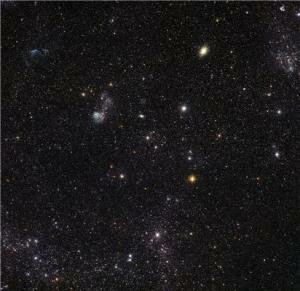Cosmic Zoo in the Large Magellanic Cloud
Astronomers often turn their telescopes to the Large Magellanic Cloud (LMC), one of the closest galaxies to our own Milky Way, in their quest to understand the Universe.
In a spectacular new image from the Wide Field Imager (WFI) at ESO's La Silla Observatory in Chile, a celestial menagerie of different objects and phenomena in part of the LMC is on display, ranging from vast globular clusters to the remains left by brilliant supernovae explosions.
This fascinating observation provides data for a wide variety of research projects unravelling the life and death of stars and the evolution of galaxies.
The Large Magellanic Cloud (LMC) is only about 160 000 light-years from our own Milky Way - very close on a cosmic scale. This proximity makes it a very important target as it can be studied in far more detail than more distant systems.
The LMC lies in the constellation of Dorado (the Swordfish), deep in the southern sky and well placed for observations from ESO's observatories in Chile. It is one of the galaxies forming the Local Group surrounding the Milky Way. Though enormous on a human scale, the LMC is less than one tenth the mass of our home galaxy and spans just 14 000 light-years compared to about 100 000 light-years for the Milky Way.
Astronomers refer to it as an irregular dwarf galaxy. Its irregularity, combined with its prominent central bar of stars suggests to astronomers that tidal interactions with the Milky Way and fellow Local Group galaxy, the Small Magellanic Cloud, could have distorted its shape from a classic barred spiral into its modern, more chaotic form.
This image is a mosaic of four pictures from the Wide Field Imager on the MPG/ESO 2.2-metre telescope at the La Silla Observatory in Chile. The image covers a region of sky more than four times as large as the full Moon.
The huge field of view of this camera makes it possible to see a very wide range of objects in the LMC in a single picture, although only a small part of the entire galaxy can be included. Dozens of clusters of young stars can be seen as well as traces of glowing gas clouds. Huge numbers of faint stars fill the image from edge to edge and in the background, more galaxies, far beyond the LMC, are visible.
Globular clusters are collections of hundreds of thousands to millions of stars bound by gravity into a roughly spherical shape just a few light-years across.

"This spectacular new image from the Wide Field Imager on the MPG/ESO 2.2-metre telescope at ESO’s La Silla Observatory in Chile reveals a celestial menagerie of different objects and phenomena in part of the Large Magellanic Cloud, a small companion galaxy to our own Milky Way. Many clusters are visible including an unusually young globular cluster and the remains of a brilliant supernovae explosion. The field of view is about one degree across. (Credit: ESO)"
Source: ESO
|